Research Activities
Scientific analysis of Cultural Heritage
We use analytical instrumentation to study production technology and provenance of archaeological materials including metal, pottery and pigment. In addition, we have a strong research emphasis on ancient biomolecules such as human and animal remains as well as organic residues. We study ancient human and animal DNA to understand the peopling of Korea, and also extract palaeodietary information using stable carbon and nitrogen isotope analysis of human and animal remains.
Material Analysis of Ancient Metal Artifacts and Investigation of Production Techniques

The State of a Collection of Wind Chimes the Size of Grains of Rice
Through the scientific analysis of metal artifacts, their structure and gradient can be measured, thereby enabling conjecture on production techniques and region.
Analytical Process
Analytical Process for Metal Artifacts
 1. Creation of a test piece for structural observation using epoxy resin.
1. Creation of a test piece for structural observation using epoxy resin.
 2. Polishing of the surface to be observed through a microscope.
2. Polishing of the surface to be observed through a microscope.
 3. Observation of the structure through an analytical microscope.
3. Observation of the structure through an analytical microscope.
 4. Analysis of the components with an X-Ray Fluorescence Spectrometer
4. Analysis of the components with an X-Ray Fluorescence Spectrometer
 5. Measurement of the hardness of each section using a Micro-Vickers Hardness Tester
5. Measurement of the hardness of each section using a Micro-Vickers Hardness Tester
 6. Analysis of the crystal structure using an X-ray diffraction analyzer.
6. Analysis of the crystal structure using an X-ray diffraction analyzer.
Metal Artifacts: Gold-Plated Bronze Artifacts
The material analysis of a gilt bronze artifact is achieved by using a video analysis terminal to observe its plating layers and internal structure, then an x-ray fluorescence spectrometer to analyze the components of each section. The following are the results of the detailed shooting and component analysis of the sarira case artifact found at the East Three-story Stone Pagoda at Gameunsa Temple Site, Gyeongju(National Treasure).
Magnification of the Fine Details of the Sarira Case Lid
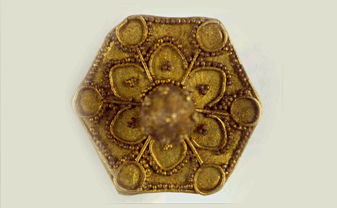 Decorated with 0.25mm wide gold threads and 0.3∼0.5mm gold grains welded on the surface (about 1.3cm long).
Decorated with 0.25mm wide gold threads and 0.3∼0.5mm gold grains welded on the surface (about 1.3cm long).
Magnification of the Fine Details of the Sarira Case Lid
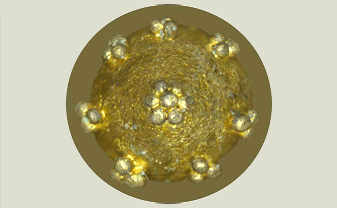 Ornamented with three gold grains welded in seven places around seven gold grains in the center. (About 0.4cm long)
Ornamented with three gold grains welded in seven places around seven gold grains in the center. (About 0.4cm long)
Standardization of Techniques for Gold Grain Utilization
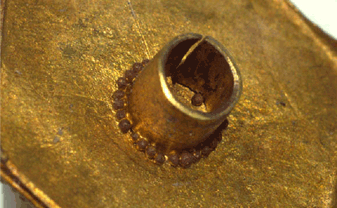 Gold grains with a diameter of 0.3mm are used with a reference point focused on a central point.
Gold grains with a diameter of 0.3mm are used with a reference point focused on a central point.
Collection Conditions for Pungtak Bells
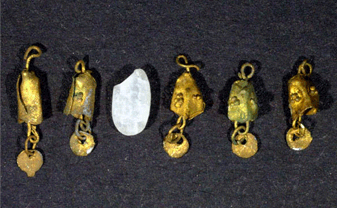 Collection Conditions for Pungtak Bells about the size of a grain of rice. Bell’s 5mm-long body ornamented with gold grains with diameter of 0.3mm.
Collection Conditions for Pungtak Bells about the size of a grain of rice. Bell’s 5mm-long body ornamented with gold grains with diameter of 0.3mm.
The condition of the internal structure of the gold grains
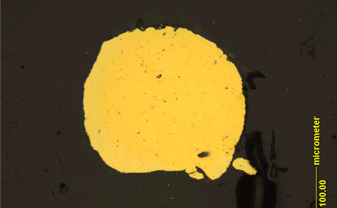 Gold of 98% purity used.
Gold of 98% purity used.
Mystery of the Gold Grain Fusing Technique
Gold grains with a diameter of 0.3mm were firmly welded using gold fusing (and also combined fusing with 10% silver content). The melting point of pure gold is 1063℃, that of pungtak bells (94% gold) is 1055℃, and that of gold fused with 10% silver is 1046℃. We can tell from this that the gold was fused using melting ranges that varied depending on the proportion of silver in each part. Thanks to this discovery we know that the Silla artisans possessed amazing metallurgical skills.
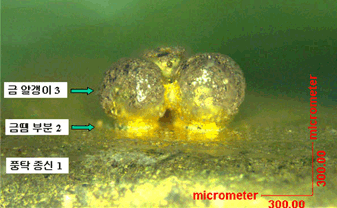 It is a fine example of a fusion technique with the amazing capacity to minimize the area affected by the fusing. → Commissure with a length of 0.18mm
It is a fine example of a fusion technique with the amazing capacity to minimize the area affected by the fusing. → Commissure with a length of 0.18mm
Bronze Artifacts: Artifacts of Copper Combined with Tin
Distribution of Composition based on Bronzeware Type
The diagram below shows the three types of bronzeware component distribution. In the bronze cutlery and bronze containers 1, there was no addition of lead, and the artifacts were identified as high quality brass tablewares that were worked at 550℃ and then water-cooled. These were generally used as food containers. The bronze containers 2 and the bronze swords contained a fair amount of lead to increase castability and make them easier to produce. The bronze containers in this group were not intended for cooking or eating, and we understand that the bronze swords were made with small amounts of tin and lead to ensure appropriate levels of hardness and strength.
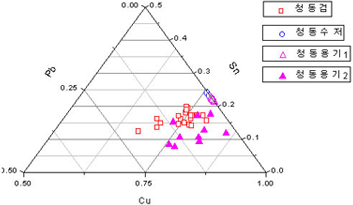 Graph of the average composition of bronzewares
Graph of the average composition of bronzewares
The Refined Structure of Bronze Artifacts
By analyzing the components and structure of bronze artifacts, it is possible to confirm whether the production method consisted of forging or casting. In the case of cast items, branch-like dendritic structure is visible, while grains are visible in forged items that have been pre-hardened. Even in the case of cast items, if they are heated over time the dendritic structure disappears and changes into crystal grain forms. Lead also does not mix with copper or tin, and generally collects and separates as round particles between the branches (Segregation). If the lead content is above 10%, the appearance of a eutectoid structure (α+δ) can be identified.
Bronze spoons
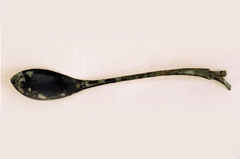 Bronze spoons
Bronze spoons
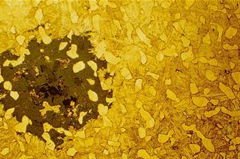 Micro-structures of bronze spoons (forging, 201×)
Micro-structures of bronze spoons (forging, 201×)
Bonze container
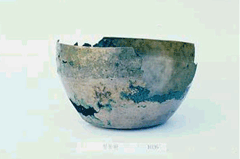 Bonze container
Bonze container
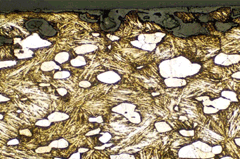 Micro-structures (forged items, 201×)
Micro-structures (forged items, 201×)
Weapons
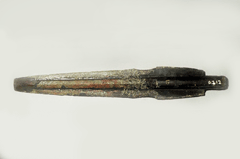 Bronze daggers
Bronze daggers
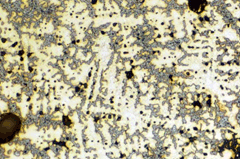 Micro-structures of bronze daggers (casting, 201×)
Micro-structures of bronze daggers (casting, 201×)
Goryeo Temple Bell
This Goryeo-period temple bell was donated by a Japanese private collector named Himiko Takahara to the Korean government, in November 1999. Standing 71cm tall and 50cm in diameter of its low section, the temple bell falls into the mid-size category.
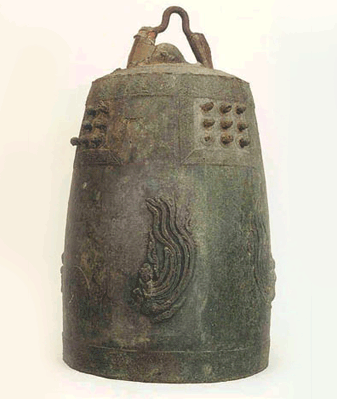 Goryeo Temple Bell
Goryeo Temple Bell
Ironware Artifacts: Artifacts Created Using Iron
The quality of iron is determined by the amount of carbon (C) found in the iron itself. Pure iron that contains no carbon melts at 1538℃. There are four kinds of solid states found in a Fe-Fe3C phase diagram. These are alpha ferrite (α), austenite, cementite, and delta ferrite. In the case of iron with 1% carbon content, if you cool the iron down from the liquid state of L, at 1430℃ crystal grains of austenite (γ) will appear and it will become γ at 1360℃. If the temperature is lowered to 810℃, the extraction known as cementite (Fe3C) will appear and slowly begin to increase. If the iron is cooled further still to 727℃, γ disappears and the ferrite (α) becomes entirely cementite. However, if the carbon content is 0.8%, pearlite will appear and cementite extracted from a pearlite base. Pearlite is an extraction that is alternatively layered with ferrite (α) and cementite (Fe3C). If the carbon content is 4.3%, the grains will not form and it will momentarily coagulate at 1130℃. Therefore this form of iron is often used as an alloy.
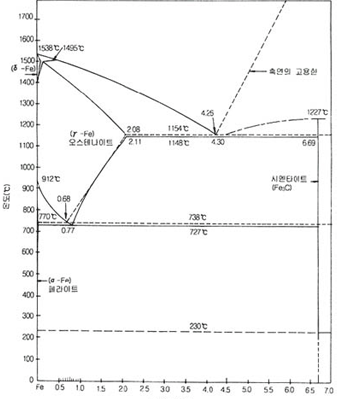 Fe-C condition graph Broken Line: Fe-Fe3C condition graph, Dotted Line:FeㆍㆍㆍC condition graph
Fe-C condition graph Broken Line: Fe-Fe3C condition graph, Dotted Line:FeㆍㆍㆍC condition graph
Types of Iron
As the carbon content increases, iron becomes stronger and more difficult to forge. As such, iron types are generally classified according to the carbon content.
1. Wrought iron : Also known as pure iron, this refers to iron with a carbon content of less than 0.1%. It is very soft and can be bent by hand. It can be forged to make items such as plates, but is not strong enough for convenience tools such as axes and knives.
2. Steel : This refers to iron with a carbon content of 0.1~1.7%. It is hard but malleable, and can be forged into a variety of objects, so it is the most widely used form of iron. It has been heavily utilized in Korea since the beginning of the Iron Age.
3. Cast Iron : Also known as pig iron, this contains carbon levels of 1.7~4.5%. It is too hard to be forged and is only used for casting. In Iron Age Korea, this was used to make implements like axes.
The Refined Structure of Ironware
Casting Items
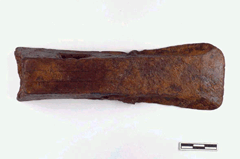 Iron pieces
Iron pieces
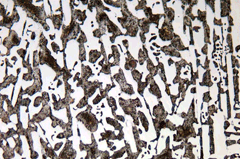 The Refined Structure of Iron pieces (200x)
The Refined Structure of Iron pieces (200x)
Forging Items
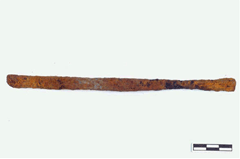 Iron Chisel
Iron Chisel
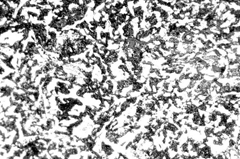 The Refined Structure of Iron chisels (200x)
The Refined Structure of Iron chisels (200x)
Examination of Pottery Techniques and Determination of Provenance

A photo of Pottery’s Polarizing Microscopes
The scientific analysis of pottery and earthenware involves the observation of mineral composition, chemical substance, firing temperature and microstructure, and the purpose is to study the manufacturing techniques. The provenance of potteries is determined by analyzing the trace element on the basis of geological characteristics of the excavated site.
Analysis
Analysis of Pottery and Earthenware
 1. Collect and categorize the pottery fragments according to the kiln sites
1. Collect and categorize the pottery fragments according to the kiln sites
 2. Categorized pottery fragments are rinsed with distilled water to remove foreign materials on the surface.
2. Categorized pottery fragments are rinsed with distilled water to remove foreign materials on the surface.
 3. Pulverize the fragments.
3. Pulverize the fragments.
 4. Analyze the main substance of the potteries by using an inductively coupled plasma mass spectrometer.
4. Analyze the main substance of the potteries by using an inductively coupled plasma mass spectrometer.
 5. The trace element of the potteries is analyzed by using a neutron activation analysis system.
5. The trace element of the potteries is analyzed by using a neutron activation analysis system.
 6. Analyze the minerals inside the potteries by using a polarization microscope.
6. Analyze the minerals inside the potteries by using a polarization microscope.
Scientific Analysis of Earthenware
Objective of Earthenware Analysis
Earthenware refers to containers made by firing clay. Earthenwares differ greatly in terms of quality and size depending on the quality of the clay used and the production method, and their ornamentation. Earthenware also reflects lifestyle and culture and, as it does not corrode at any sedimentary level, well-preserved ancient artifacts have served as fundamental materials for archae-ological research. However, in standard research on earthenware, external factors such as design and malformities have played the main role in the classification and recording of forms. Recently though, more attention has been paid to the information hidden inside earthenware, which is accessible through scientific methods. There are two main goals of the scientific analysis of earthen-ware, one being to determine the production methods and techniques used, and the other being to identify the region of origin. Earthenware production techniques are investigated by analyzing mineral composition, chemical composition and plastic temperature, as well as by matter analysis accom-panied by a structural examination. Estimations of the area of production are made by analyzing microelements based on evidence of the geological characteristics of the region in which the earthenware and pottery used as raw materials were found. Through these estimations of the area of production, we can not only gain a better understanding of ancient trade and exchange relationships, but also of the political, economic and cultural relationships between the area of production and the area of utilization, and through this improve our understanding of such issues as modes of production and class issues in the society of the period.
Earthenware Analysis Methods
Within the clay that makes up the base material for earthenware, elements such as Si, Fe, Al, Mg, Ca, Na, etc. can be found. The type and ratio of these elements have an effect on determining the quality of the clay. Therefore, in the study of the type and the structure, as well as the interactions, of these minerals and their auxiliary minerals within the clay, a number of natural scientific methods of analysis are used. Scientific methods of analyzing earthenware can be divided into mineral analysis, chemical analysis, and thermal analysis. In mineral analysis, devices such as polarizing microscopes and scanning electron microscopes are the most widely used, while in chemical analysis there is widespread use of X-ray diffraction analysis, atomic absorption analysis, X-ray fluorescence analysis, neutron activation analysis, inductively-coupled plasma atomic emission spectroscopy, and so on. In themal analysis, analysis methods such as differential thermal analysis, thermo gravimetric analysis and heat expansion analysis are used to measure the plastic temperature of earthenware.
Division of Production Areas that Utilized Earthenware
Earthenware is produced from clay, and clay is acquired from a clay stratum, an area within a geological space. Clay is a product of geological and geochemical processes caused by through the weathering of rock. Even though rocks are weathered into clay, within the clay thus produced there remain the chemical characteristics of the original rock. Clay reflects the chemical composition of the rocks that make up the base of any given region. Therefore, the differences in the chemical compo-sition of the base of earthenware reflect regional differences. However, the main components that make up clay are elements like Si, Al, Fe, Ca, K, Na, and Mg. If you analyze and compare the main components from each clay production area, the content distribution ranges often clash, making this an inappropriate method of differentiating clay by region. Therefore, for estimations of earthenware production areas, the analysis of microelements is more effective than that of primary components.
However, in the differentiation of production region by microelement content, there is as yet no experimental standard by which to judge which elements hold accurate. Therefore, we need to analyze microelements quantitatively and divide these by production region. As artifacts like earthenware represent particularly uneven material, and additives affect the concentration of the microelements, this type of analysis of the majority of the elements is a way of overcoming this kind of bias. When looking for the average, standard deviation and coefficient of variation (standard deviation/average x100) for these multiple components in order to determine a component that works as a means of differentiating regions, the components requiring identification are those with a large degree of average difference and a small degree of standard deviation difference.
Regional Differentiation of Earthenware at Gyeongsangnam-do Kiln Sites
The results of statistical analyses of production regions of earthenware found at five regions in Gyeongsangnam-do where kiln sites are located show that the earthenware can be divided into roughly four groups. This indicates that the kiln sites have no geological interrelationship.
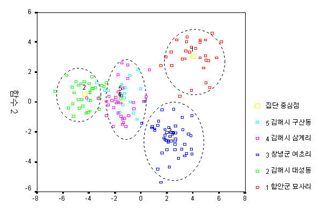 Statistical Analysis Results of Gyeongsangnam-do Earthenware Kiln Sites
Statistical Analysis Results of Gyeongsangnam-do Earthenware Kiln Sites
Analysis of Ancient Pigment

Red clay base pigment of West Three Royal Tombs, Goyang of King Yeongjo’s daughter
Pigments of different ages can be compared and studied through the analysis of ancient pigment, and techniques of ancient wall paintings can be identified through the analysis of sectional structure.
Comparison of ancient and modern pigments
In Korea, the most ancient pigment dates back to the tomb paintings of Goguryeo Kingdom.
Most of the ancient pigments on such wall paintings are made of inorganic minerals. Since it's very difficult and costly to buy mineral pigments nowadays, cheaper and easy-to-get synthetic pigments are usually used as a substitute paint.
Pigment analysis of clay in the storage room of the placenta of Yeongjo's daughter at West Three Royal Tombs, Goyang
The analysis of an ancient pigment begins with a qualitative analysis to break down a pigment sample by color, using an X-ray fluorescence spectrometer. Minerals of different colors are, then, analyzed using a micro-area X-ray diffractometer. The following are the results of the analysis of pigments found in the red clay in the placenta room of King Yeongjo's daughter at West Three Royal Tombs, Goyang.
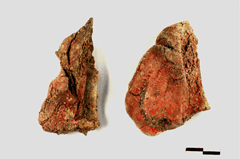 Clay in the placenta room of Yeongjo's daughter at West Three Royal Tombs, Goyang
Clay in the placenta room of Yeongjo's daughter at West Three Royal Tombs, Goyang
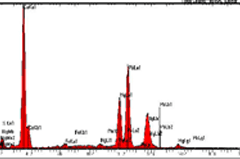 Results of qualitative analysis of the red pigment using a micro-area X-ray fluorescence spectrometer → Main components: Ca, Pb, Hg
Results of qualitative analysis of the red pigment using a micro-area X-ray fluorescence spectrometer → Main components: Ca, Pb, Hg
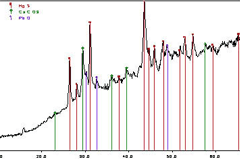 Results of qualitative analysis of the red pigment using a micro-area X-ray fluorescence spectrometer → Main components: Ca, Pb, Hg Results of mineral analysis of the red pigment using a micro-area X-ray diffractometer → HgS (cinnabar), CaCO3 (calcite), PbO (lead monoxide)
Results of qualitative analysis of the red pigment using a micro-area X-ray fluorescence spectrometer → Main components: Ca, Pb, Hg Results of mineral analysis of the red pigment using a micro-area X-ray diffractometer → HgS (cinnabar), CaCO3 (calcite), PbO (lead monoxide)
Cross-section of the wall behind the mural of Geungnakjeon Hall of Bongjeongsa Temple, Andong
Using an image analyzer on cross-sectional images of a mural can reveal secrets of its creation.
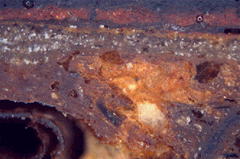 Cross-section photo of the wall behind the mural of Geungnakjeon Hall of Bongjeongsa Temple, Andong (objective lens with 5× zoom ratio)→ Paint layer, ground layer (yellow clay and white clay layers), support
Cross-section photo of the wall behind the mural of Geungnakjeon Hall of Bongjeongsa Temple, Andong (objective lens with 5× zoom ratio)→ Paint layer, ground layer (yellow clay and white clay layers), support
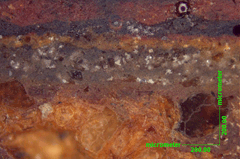 Magnified cross-section photo of the wall behind the mural of Geungnakjeon Hall of Bongjeongsa Temple, Andong (objective lens with 10× zoom ratio)→ Paint layer (94~150㎛), ground layer (yellow clay layer: 32~77㎛, white clay layer: 160~211㎛)
Magnified cross-section photo of the wall behind the mural of Geungnakjeon Hall of Bongjeongsa Temple, Andong (objective lens with 10× zoom ratio)→ Paint layer (94~150㎛), ground layer (yellow clay layer: 32~77㎛, white clay layer: 160~211㎛)
Scientific Analysis of Excavated Organic Samples
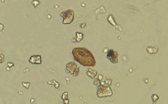
Research and Scientific Analysis of Excavated Organic Samples
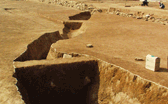
Stable Isotope Analysis of Fossil Material
Through scientific analysis of the fossil remains and organic components of microorganisms and pollen found in organic samples taken from archaeological sites, we are pursuing the goal of scientifically reinterpreting the lifestyles and cultures of ancient peoples, including dietary practices and disease epidemiology. In particular, the biological diversity and organiccomponents found at toilet sites, regarded as important historical sites where we can directly identify information related to lifestyle, environment, and the metabolism of ancient organisms, also provide precious data through which we can infer much information.It is hoped that this kind of ‘organic soil analysis,’ which holds so much information about past civilizations, can be used not only in Korea but also throughout East Asia in order to shed new light on ancient history.
Research Precedents Related to the Significance of Soil
1. What Soil Means to Soil Science
As a result of the combined processes of soil formation factors such as local climate, flora and fauna, parent rock composition and structure, geography and time, soil is a historical and independent natural body created on the earth’s surface.
2. What Are the Sedimentary Layers Excavated at Historical Sites?
Much more than just spaces containing ancient artifacts and relics, historical sites reveal their process of development and original environment. Therefore, to further our understanding of historical sites, it is necessary to investigate a wide variety of materials related to the environment of the period, including archaeological materials. These must then be analyzed in various ways (Clay mineral analysis, grading analysis, hydrogen ion exponent analysis, organic analysis, etc) in order to extract as much data from them as possible.
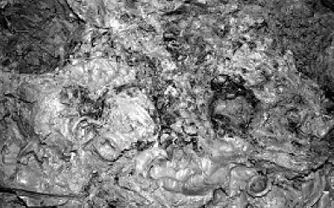
Materials that provide data about organic and inorganic matter in sedimentary layers include:
1. Material that restores the period environment
2. Material related to human life economy
3. Material recorded with relative chronology
4. Material related to human behavior patterns and technological development (The acquisition, processing and use of foodstuffs) as well as nutrition and diet.
Korean Cases
Analysis of the parasite eggs and pollen of the low, moist historical sites at Sinchang-dong 金原正子 金原正明(1997). National Gwangju Museum, Low, Moist Historic Site Sinchang-dong Gwangju 1
Japanese Cases
- Explanation of the Character of Historical Traces through Analysis of Fatty Acid in Soil
- 中野益男. 1984. [殘存脂肪分析の現狀], [歷史公論] 第10卷 第6號
- The use of the distribution ratio of microelements between obsidian and earthenware pottery solves the issue of the trade relationship between places of origin, manufacture and consumption.
- 中野益男. 1985. [特集. 黑曜石硏究の現狀].
[考古學ジヤ-ナル] No. 244.
- 中野益男. 1985. [特集. 黑曜石硏究の現狀].
- Detection of parasites such as roundworms in soil sediments dating from the 8th century.
Excavation of a number of wooden artifacts identified as chugi sticks used in toilet facilities.
Preparation of an archaeological opportunity for toilet facilities.
- 金原正子 金原正明(1995).
日本文化財科學會 第12回大會硏究 發表要旨集
- 金原正子 金原正明(1995).
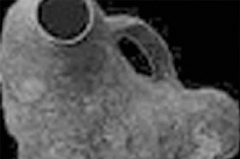 Data Type
Data Type
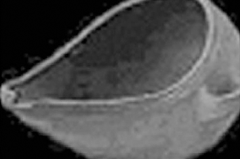 Data Type
Data Type
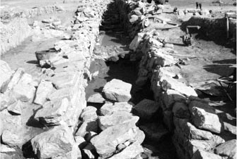 Data Type
Data Type
Western Cases
- Research on Understanding of Historical Toilet Sites and Dietary Practice through the analysis of 5β-stanols.
- Investigation into ancient dietary patterns through the analysis of carbon stable isotopes.
- Investigation into the use of historical sites through the analysis of nitrogen stable isotopes and research into the agricultural history of ancient peoples.
- Research into lifestyle history following an investigation of types of fecal pollution through the analysis of bile acids.
- Research on ancient life activity patterns through organic molecules (Proteins, lipids, food remains).
Cautions for Soil Samples Collection
Samples Collection
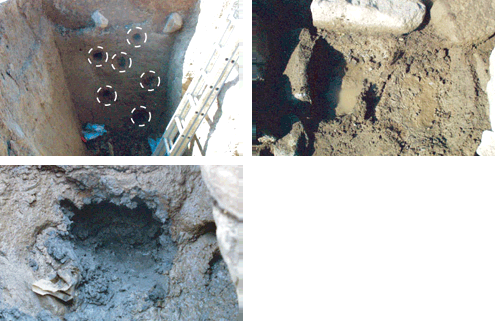
Cautions for Samples Collection
1. Soil samples must be collected without damaging nearby artifacts (if possible, request the presence of an archaeological excavation specialist)
2. wear a pair of gloves (preferably in latex) to reduce the chance of sample contamination.
3. use a garden trowel and a chisel (tools must be cleansed before their next use).
4. samples must be collected from at least five different areas (according to the depth, width, color and surface of the artifact).
5. Remove a surface layer of about 5cm depth before taking the sample, to minimize errors caused by contaminated samples.
6. make sure that control soil samples are also collected from surrounding areas (control samples must also be taken from at least five different areas).
7. use aluminum foil or glass jars as the receptacles (plastic bags may be used at the collection site, to temporarily hold the samples).
8. All receptacles must be labeled with basic information, including the site of sample collection, its general location, date and the name of the collector.
9. Soil samples must be stored at a cool temperature, away from light (In a shaded storage area or at 4℃ in a refrigerator)
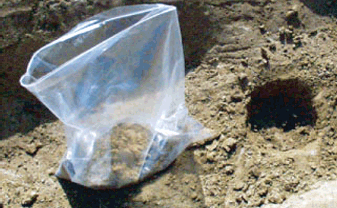
Mimetic Diagrams of Historical Site Excavation Soil
Samples Collection
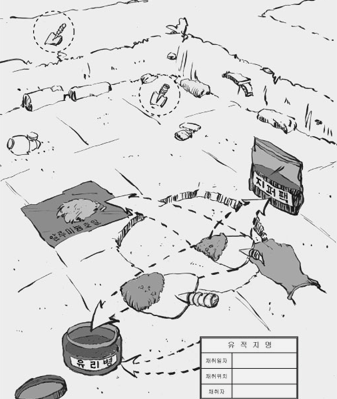 Contrast soil from the vicinity to be collected from five clearly specified locations
Contrast soil from the vicinity to be collected from five clearly specified locations
※ Recorded Items of Historical Site Excavation Soil Survey Investigation
Excavation Site, Excavation Date, Person in Charge, Altitude above Sea Level (Distance from Ocean), Use of Soil (present condition of farmlands, fields, etc), Climate, Differentiation of Soil Class and Stratum (viscosity, color, particle thickness), Thickness of Soil Stratum (excavation site soil stratum base line data), dry condition (dryness, moisture), Presence and Type of Rocks (general rock types such as granite, marble and sandstone), Presence and Type of Grains, Presence and Type of Bone Splinters (expressed as far as possible as fish bones, human bones, etc), Presence and Type of Plant Bodies (expressed as far as possible as rice straw, etc)
Soil Analysis Research and Expected Effectiveness
Research on the Basic Characteristics of Ancient Soil
- Study on characteristics such as the amounts of inorganic and organic materials
- Investigation of the Dietary Practices and Living Culture of Ancient Human Residents of the Site
Research on the Characteristics of Historical Vestiges
- Analysis of the Quantity and Quality of Soil Components through Fatty-Acid Analysis (TLC, GC/MS)
- Remains of ancient toilets, Investigation of vaious uses of artifacts such as livestock husbandry
Disease Research on Ancient Peoples
- Molecular biological and morphological research on microorganisms and parasites
- Investigation into the disease profile of ancient human residents of the site by analyzing the state of soil pollution
Research into the Paleoenvironment of the Area around the Historical Site
- Morphological Research on Pollen, Leaves, Roots, etc
- Investigation into the Characteristics of the Ancient Vegetation and Environment of the Historical Site
Research into Fossil Characteristics
- Genetic and Molecular Biological Research on the Fossils Extant within the Soil
- Species Groupings of Fossils through Genetic Analysis and Morphological Differentiation
- Creation of a Fossil Database for the Korean Peninsula through Genetic Comparison with Modern Species
Report on the Results of Earth Analysis at the Wanggung-ri Remains Site
1. Analysis Objective
Scientific interpretation of ancient soil through the analysis of fossils and the organic components of soil at historical remains to shed light on the dietary life history, paleoenvironment and disease profile among ancient peoples, the movements of fossil species, and genetic research.
2. Target of Analysis
Wanggung-ri Historical Remains (Historic Site 408) in Iksan-si, Jeollabuk-do Five points of earth at the large-scale pit remains in the northwest region (Excavation Institution: Buyeo National Research Institute of Cultural Heritage)
3. Analysis Period
June to November 2004 (Six months)
4. Analysis Responsibility
Research Division of Conservation Science of the National Research Institute of Cultural Heritage
5. Analysis Process
November 2003 Excavation of Organic Soil at Wanggung-ri, Iksan by the Buyeo National Research
Institute of Cultural Heritage (Fig. 1)
- Large-size Pit Remains (Length: 10.5m / Width: 1.7m / Depth: 3.6m)
March 2004 Procurement of Excavated Soil Samples from the Buyeo National Research Institute of Cultural Heritage (Fig. 2)
- Procurement of Soil Samples distinguished by depth and color from five locations (A,B,C,D,E). (Table 1) : A(240~250cm), B(280cm), C(326cm), D(350cm), E(360cm)
- Storage of Soil Samples in Laboratory Refrigerated at 4℃
Analysis of Soil Color, Soil Class and Texture
- Assessment of Soil Texture based on Comparison with Granularity Characteristics Soil Assessment Division Method (Gwak Jong-gil, 1995)
- Division of Soil Color by Munsell Color Chart
Total Organic Compound Content Analysis
- Analyze Organic Compound Content through Loss on Ignition Test (Carter, 1993)
- Reduce over 1 hour 30 minutes in a high temperature furnace (Furnace Type 47900, USA) at an incandescent temperature of 500℃
pH Measurement
- Measure by combining soil samples with distilled water at a ratio of 1:5 and using the Soil PH Measurement Test (Jo Song-jin, 2002)
- Use of a pH Meter (Hanna Madel Hi9024C, USA) adjusted for pH 4.01 and 7.01
Observation of Parasite Eggs
- Bring parasite eggs to surface using 40ml of 0.5% Sodium Phosphate Tribasic
- Observe Parasite Eggs through a polarizing microscope (Zeiss Axioplan2 Polarize Microscope, Germany)
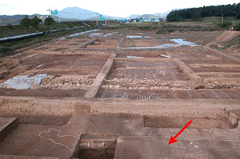 Fig.1. View of Wanggung-ri Relic Site in Iksan. The arrows indicate pit remains excavated from organic soil
Fig.1. View of Wanggung-ri Relic Site in Iksan. The arrows indicate pit remains excavated from organic soil
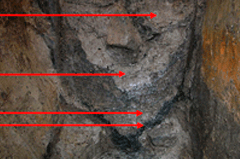 Fig.2. The cross section of soil layer of pit remains, and the location of specimen collection
Fig.2. The cross section of soil layer of pit remains, and the location of specimen collection
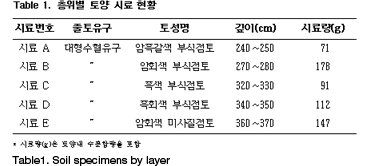 Table1. Soil specimens by layer
Table1. Soil specimens by layer
6. Analysis Results
Analysis of Soil Color, Soil Class and Texture
- It is possible to divide the edges of soil layers by color. (Fig. 2)
Soil with an uneven horizontal structure is visible. - Overall, each soil layer has been confirmed as dark black humus clay.
- Sample A: dark brown humus clay
- Sample B : dark gray humus clay
- Sample C : black humus clay
- Sample D : gray-black humus clay
- Sample E : dark gray silt clay. (Table 1)
- Notably, Sample A was found to contain large amounts of organic materials such as seeds and grains. (Fig. 3)
Total Organic Compound Content Analysis
-
Organic compound content analyzed through LOI.
: The results of the analysis of the soil samples’ organic compound content were as follows : Sample A
22.124%, Sample B 7.670%, Sample C 6.909%, Sample D 8.086%, Sample E 8.295% (Table 2 and
Fig. 4) - The higher organic compound content of Sample A is assumed to be humus.
pH Measurement
-
All soil samples from Wanggung-ri, Iksan have been identified as acidic soil.
: The results of the pH analysis of the soil samples are as follows: Sample A 2.86, Sample B 5.95,
Sample C 4.77, Sample D 3.67, and Sample E 4.18. - The results showed that Samples A, D and E were extremely acidic, Sample B was medium acidic, and Sample C was very strongly acidic. (Table 4)
Observation of Parasite Eggs
- All samples were confirmed to contain whipworm eggs (Trichuris trichiura). (Fig. 5)
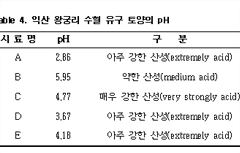 Table4: Ph of the pit remain soil from Wanggung-ri, Iksan
Table4: Ph of the pit remain soil from Wanggung-ri, Iksan
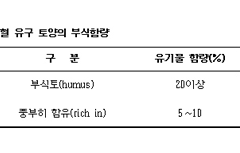 Table3: Corrosion content of pit remain soil from Wanggung-ri, Iksan
Table3: Corrosion content of pit remain soil from Wanggung-ri, Iksan
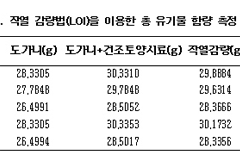 Table2: Total organic content measurements using LOI (Loss on Ignition)
Table2: Total organic content measurements using LOI (Loss on Ignition)
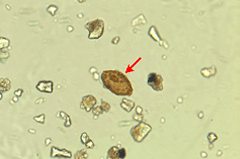 Fig5: Appearance of whipworm eggs among human parasites found from pit remains of Wanggung-ri, Iksan
Fig5: Appearance of whipworm eggs among human parasites found from pit remains of Wanggung-ri, Iksan
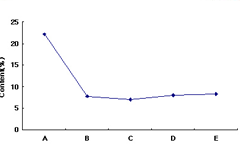 Fig4: Graph of total organic material measurements
Fig4: Graph of total organic material measurements
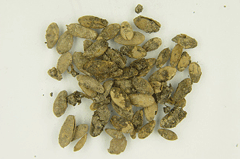 Fig3: Seeds from specimen soil of relic site A of Wanggung-ri, Iksan
Fig3: Seeds from specimen soil of relic site A of Wanggung-ri, Iksan
7. Summary and Considerations
Overall, each soil layer has been confirmed as dark black humus clay.
- Sample A: dark brown humus clay
- Sample B : dark gray humus clay
- Sample C : black humus clay
- Sample D : gray-black humus clay
- Sample E : dark gray silt clay.
The results of the LOI analysis showing an organic compound content level in Sample A of 22.124% has been presumed as humus.
It has been confirmed that the soil at Wanggung-ri, Iksan is acidic soil.
- The characteristic of this kind of soil is that organic material within the soil is corroded over a long period of time, which proves that large amounts of organic matter that existed in the pit remains.
In the future it will be necessary to utilize high-tech devices such as organic matter analyzers (GM/MS) and infrared spectrometry analyzers (FT-IR) to confirm the characteristics and perform quantitative and qualitative analysis of the organic material.
The results of the microscopic inspection of parasite eggs reveal the presence of whipworm (Trichuris trichiura) eggs at all sample sites.
- As whipworms are a parasite of the human gut, these are presumed to have been released through the bowel movements of humans infected by the parasites. In the future, it will be necessary to create a whipworm genetic information and biological genealogy through molecular biological analysis.
8. Future Plans
Creation of the 2nd Organic Material Analysis Experimental Plan for the Historical Sites at Wanggung-ri, Iksan, Jeollabuk-do.
- January to November 2005
Extraction and Refinement of Geological Features within the Soil.
- Extraction and refinement of geological features of the soil using ultrasonic extraction and thin-layer chromatography (TLC).
- Geological separation extraction through TLC.
Qualitative and quantitative analysis of organic material components of ancient soil using organic material analyzers
- Stage 1 : Investigation of the usage of the remains through Coprostanol qualitative analysis.
- Stage 2 : Inquiry into herbivorous and omnivorous animals through Coprostanol / 5β-Stanols quantitative analysis.
- Stage 3 : Differentiation of omnivorous species through quantitative and qualitative analysis of bile acids.
- Investigation of the dietary and cultural history of ancient peoples.
Procurement of Biochemical Research Data on the Soil of Ancient Remains
- Procurement of Biochemical Research Data on a number of ancient remains sites and various modern soil types.
- Database for the Restoration of Ancient Dietary Practices and the Diverse Environments of the Korean Peninsula
Reference
Gwak Jong-gil. 1995. Investigation/Materials/Analysis Methods of Alluvial Soil Remains. Gomunhwa No. 47 pp 3-26
Jo Seong-jin, Eom Dae-ik, etc. 2002. Inspection Soil Study. Hyangmunsa.
Stable Isotope Analysis of Fossil Material
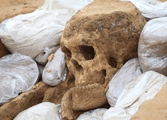
Stable Isotope Analysis of Fossil Material
The types of sustenance consumed by humans and animals leave distinct traces on the structure of bone collagen and bone apatite carbonate produced within bones as well as hair keratin, which is recorded in the unique stable isotope information, and it is known that these ratios do not change even over time. Of these, information on the carbon and nitrogen stable isotopes produced in bone collagen can be widely utilized in the study of ancient dietary practices.
So far, the dietary information measured through δ13C and δ15N analysis includes evidence of the consumption of C₃, C₄, CAM plants, amounts of animal protein consumed, evidence of the consumption of land animals, seawater fish and freshwater fish, the quality and relative consumption levels of protein, etc. If we can extract stable isotope information from when the fossils were alive, we will be able to recover the ancient dietary practices (By period, region, funeral rites, class, gender, age, etc) as well as the nutritional conditions of that time.
Stable Isotope Analysis of Collagen Extracted from Human Bones
Stable Isotope Analysis of Collagen Extracted from Human Bones Collagen Extracted using the modified Longin Method (A Process of Demineralization, Gelatinization and Lyophilization (Van Klinken and Hedges, 1998, Radiocarbon, 40, 51-56)
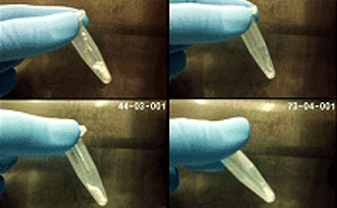 Collagen Extracted from Excavated Human Bones
Collagen Extracted from Excavated Human Bones
Stable Isotype Constitution of Fossil Remains Analyzed through a continuous-flow stable isotope ratio mass spectrometer with elemental analyzer (Delta V, Thermo Fisher Scientific (Bremen))
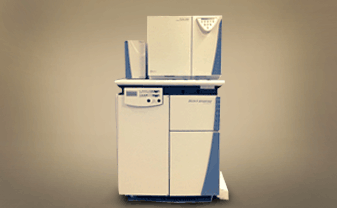 Isotope-ratio Mass Spectrometry (IRMS)
Isotope-ratio Mass Spectrometry (IRMS)
The Stable Isotope Ratio (δ13C, δ15N) of Carbon (C) and Nitrogen (N) compared to the isotope reference sample (VPDB and AIR) and in the last stage of analysis compared to the C/N ratio of each sample
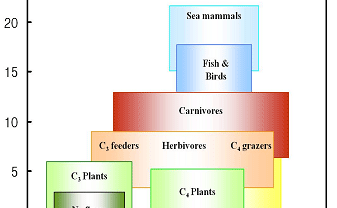 The Stable Isotope Ratio of Carbon and Nitrogen Based on the Foodchain
The Stable Isotope Ratio of Carbon and Nitrogen Based on the Foodchain


